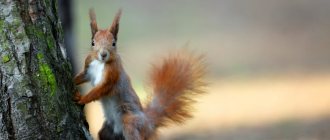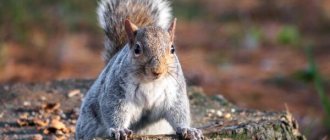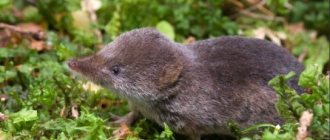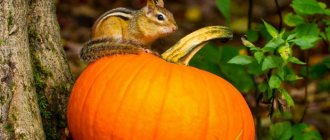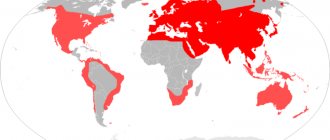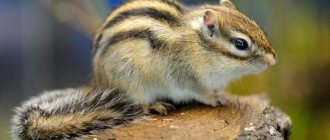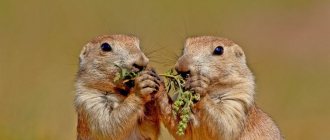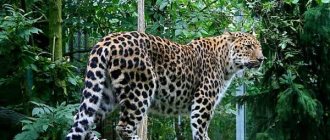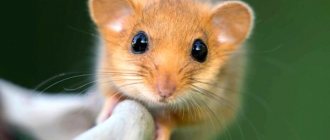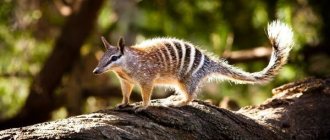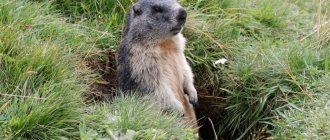Description of the rodent
— Advertising —
Squirrels have an elongated body with a long fluffy tail, long ears, often with tassels, the fur is dark brown or red with a light belly, and often turns gray in winter. In general, the color of squirrels is very diverse and differs depending on their habitat.
Squirrels molt twice a year; once a year, only the tail sheds. Spring molting occurs from April to May, autumn molting occurs in September-November.
Characteristics and description of the animal
Squirrels live alone and gather in groups only during migrations or severe frosts. Under favorable conditions, the animals remain within the same territory, but they are not characterized by clear demarcation of areas and clashes with relatives who violate the boundaries.
Squirrels can change their habitat in case of food shortage, moving over distances of 50 to 200 km. At the end of summer and beginning of autumn, seasonal migration of young animals occurs: grown-up squirrels leave the parental nest and go in search of their own territory.
Squirrels lead a predominantly arboreal lifestyle and descend to the ground only for a short time. The crown of trees hides them from predators and provides them with food.
Squirrels not only climb deftly and jump from branch to branch, but also swim well. If necessary, they can cross wide rivers and lakes. When plunging into the water, the animal lifts its tail up and swims. If for some reason the long, bushy tail gets wet, the squirrel may drown.
What does a squirrel look like?
Golden-bellied
The external structure of the animal has the following features:
- the body is thin, elongated;
- the hind legs are longer and have more developed muscles; the toes have sharp claws;
- the head is rounded with a muzzle slightly extended forward, the ears are long, in some species they end in a tassel;
- The squirrel's tail is completely covered with hair, its length is usually 2/3 of the length of the animal's body.
The color of the squirrel depends on the variety, habitat and season. Albinos and melanists occasionally appear in female common squirrels.
Squirrel fur
Western gray
The growth density of hairs on the body of a squirrel is 7-9 thousand per 1 square meter. cm. The length of the guard hairs is 2-2.5 cm, the underhairs are 2 times shorter.
The squirrel has long been considered a fur-bearing animal. Large-scale production of rodent skins began in the 18th century and lasted until the middle of the last century, after which the fishery began to decline.
Squirrel fur belongs to the fur of the middle price category. It is light, soft and quite thick, but not very warm and quickly loses its appeal. Most often, squirrel is used for decorative finishing of products. The highest quality skins are those obtained after the end of the autumn molt.
How many years do they live
The lifespan of a squirrel largely depends on living conditions. Individuals living in nature live only up to 4-5 years. The premature death of animals is usually associated with attacks by enemies or lack of food during the winter months.
Animals kept at home often reach the age of 10-12 years. The record documented lifespan of a squirrel was 23.5 years. The longest-living species was the captive Carolina squirrel.
ELK
Nutritional features of squirrels
Squirrels are omnivorous rodents and feed on a wide variety of foods, the bulk of which are seeds of coniferous trees (spruce, pine, Siberian cedar, fir, larch). In the south of the range, in oak forests with hazel undergrowth, they feed on acorns and hazelnuts. Squirrels also readily eat mushrooms (for example, deer truffle), buds and young branches of trees, berries, tubers and rhizomes, lichens, and herbs. When the main forage crop fails, the share of the latter in the diet increases. During the mating season, squirrels often switch to animal food, eating insects and their larvae, eggs, chicks, and small vertebrates. After winter, squirrels gnaw the bones of dead animals.
— Advertising —
For the winter, squirrels stock up on acorns, nuts, and cones, which they store in hollows or bury among the roots, hang on branches and dry mushrooms. Squirrels usually forget about such reserves, and in winter they find them only by accident; instead of their owners, birds, rodents, and brown bears feast on them. At the same time, the squirrels themselves eat the supplies made by chipmunks , nutcrackers and mice.
The daily amount of food varies by season: in spring, squirrel eats up to 80 g per day, in winter about 35 g.
How squirrels prepare for winter
Preparation for winter is typical for those species of squirrels that live in the temperate climate zone. Before the onset of cold weather, squirrels line the hollow with dry grass, moss, and wool. In the fall, the animals begin to harvest acorns, nuts and cones, hiding them in hollows, crevices of trunks and between the roots of trees. Squirrels do not remember exactly where they left their supplies, so during the winter they consume only a quarter of the hidden food. The rest serves as food for other forest inhabitants.
The squirrel does not hibernate, but in severe frosts and snowstorms it can sleep for several days and not leave its shelter. To survive the cold months, rodents gather in small groups. Sometimes 4-6 individuals can winter in one hollow or nest.
Animals living in milder climates (for example, Abert's squirrel) do not stock up.
Common types of squirrel
Abert's squirrel (Sciurus aberti)
Body length 46-58 cm, tail 19-25 cm. There are tassels 2-3 cm long on the ears. The coat is gray, with a brownish-red stripe on the back. The head is round in shape, the eyes are black.
It lives in coniferous forests of the southwestern United States and Mexico.
Guiana or Brazilian squirrel (Sciurus aestuans)
The body length reaches 20 cm, the tail is about 18 cm long. Weight is 180 g. The color is dark brown.
The species is endemic to South America (Argentina, Brazil, Guyana, French Guiana, Suriname and Venezuela). Lives in forests and city parks.
Allen's squirrel (Sciurus alleni)
The female's body length is about 25 cm, tail up to 20 cm, weight up to 500 g. Males have a body length of 27 cm, tail 17 cm, weight reaches 450 g. In winter, the back and sides are yellowish-brown, with gray and black. The top of the head is dark. The eye rings are pale orange. The ears are brownish-gray. The feet are whitish-gray or yellowish-brown. The belly is white. The top and bottom of the body are separated by a narrow pale gray line. The tail is black on top, with graying. The bottom is bluish-yellowish-brown or yellowish-gray. In summer the squirrel becomes darker. The fur on the back is soft and thick, the tail is fluffy.
The species is endemic to northern Mexico, where it lives in oak and oak-pine forests.
Persian or Caucasian squirrel (Sciurus anomalus)
The body length is 20-25.5 cm, the tail is 13-17 cm, the weight is in the range of 332-432 g. The ears are short, there are no tassels. The coat is bright, brownish-gray on top, chestnut-brown on the sides. The belly and breast are either bright rusty or light. The tail is chestnut-rusty or light brown.
The species is distributed in the Middle East and the Caucasus, Transcaucasia, Asia Minor and Western Asia, Iran, and the islands of Lesbos and Gokceada in the Aegean Sea.
Arizona squirrel (Sciurus arizonensis)
Outwardly it looks the same as Abert's squirrel. It is found in the mountainous regions of central Arizona and Mexico, at altitudes from 1500 to 1900 meters above sea level in coniferous, mixed and deciduous forests.
Golden-bellied squirrel (Sciurus aureogaster)
The female’s body length is 26 cm, tail length is about 25 cm, weight is 500 g. The male’s body length is 27 cm, tail length is 25 cm, weight up to 500 g.
Inhabitant of Guatemala and Mexico, where it lives at altitudes up to 3800 m, in forests, as well as in urban areas.
Carolina squirrel (Sciurus carolinensis)
Body length is from 38 to 52 cm, tail is 15-25 cm long. The fur is gray with brown and red “tan marks”.
It is found in North America, as well as in Scotland, Ireland, England and Italy, in coniferous forests.
Collier's squirrel (Sciurus colliaei)
The back is yellowish-gray, the sides are pale, the belly is light. The tail is black and white above, bluish-gray or blackish-yellow and white below.
The species is endemic to Mexico, where it lives in tropical and subtropical forests along the Pacific coast.
Deppe's squirrel (Sciurus deppei)
The upperparts are dark red-brown with gray to yellowish-brown or grayish-brown. Paws are gray. The tail is black and white at the top, rusty at the bottom. The belly is white or yellowish to dull red.
It lives in Belize, Costa Rica, El Salvador, Guatemala, Honduras, Mexico and Nicaragua, in evergreen and semi-evergreen moist and dense forests.
Fire squirrel (Sciurus flammifer)
Body length is about 27 cm, tail up to 31 cm. The head and ears are red, the upper body is bluish-yellow and black. The belly is white. The tail is basically black, the rest is orange.
Distributed in Venezuela.
Yellow-throated squirrel (Sciurus gilvigularis)
Body length is up to 17 cm, tail length is 17-18 cm. In color, the species resembles the Guiana squirrel, but is lighter than it. The back is reddish-brown, the belly is reddish-orange. The tail is striped.
The species is endemic to South America, found in Brazil, Guyana, and Venezuela.
Red-tailed squirrel (Sciurus granatensis)
Body length 33-52 cm, tail length 14-28 cm. Weight 230-520 g. Head elongated. The back is dark red, but there are individuals with a gray, pale yellow or dark brown color. The abdomen and breast are white to bright red. The tail is bright red with a black tip.
The species lives in Central and South America, in tropical and seasonal forests at altitudes up to 3000 m above sea level.
Western gray squirrel (Sciurus griseus)
The largest species. Body length is 50-60 cm, tail length is 24-30 cm, weight is in the range of 520-942 g. The back is silver-gray, the belly is white. The ears are large, without tufts. The tail is long. The ocular ring is white. The eyes are yellow.
It lives in Mexico and the USA, in oak-coniferous and mixed forests.
Bolivian squirrel (Sciurus ignitus)
Body length is about 18 cm, tail up to 17 cm, weight 220 g. The back is variegated brown, the tail has a reddish tint. The belly is reddish-yellow-brown.
Found in Bolivia, Brazil, Colombia, Argentina and Peru, in tropical forests.
Japanese squirrel (Sciurus lis)
Outwardly similar to the Nayarit squirrel. It is endemic to the Japanese islands.
Nayarit squirrel (Sciurus nayaritensis)
The body length of females is about 28 cm, the tail is 27 cm. Males reach a length of 30 cm, the tail is 28 cm long. Weight is 750 g. The head is round in shape, the eyes are black. The coat is soft, the back is reddish-brown. The tail is fluffy and long.
Found in southeastern Arizona and Mexico.
Fox or black squirrel (Sciurus niger)
Body length is 45-70 cm, tail length is 20-33 cm. Weight is in the range of 500-1000 g. The fur is from light brown-yellowish to dark brown-black. The belly is light. There is a white pattern on the tail and face.
The species is widespread in North America.
Spotted squirrel (Sciurus variegatoides)
Large species with a long tail. Body length 22-34 cm, tail length 23-33 cm. Body weight 428-909 g. Coat color is varied.
Lives in the forests of Central America and Mexico.
Common squirrel (Sciurus vulgaris) or wecksha
The body length is 20-28 cm, the tail length is 13-19 cm, the weight is 250-340 g. The head is round in shape, the eyes are black and large. The ears are long and tufted. The tail is flattened. Winter fur is soft and fluffy, summer fur is hard, sparse, and short. The color is very variable, more than 40 subspecies have been described. In summer with red, brown or dark brown tones, in winter with gray and black. The belly is white or light.
The species is widespread in Eurasia from the Atlantic to Kamchatka, Sakhalin and Japan.
Yucatan squirrel (Sciurus yucatanensis)
Body length 20-33 cm, tail length 17-19 cm. The fur on the back is gray with black and white. The belly is sandy or gray, sometimes to grayish-black or black. The paws are dark brown, sometimes black. The tail is black with white spots.
It is found in the Yucatan Peninsula, as well as in Mexico, Guatemala and Belize, in deciduous and tropical forests.
Habitat
Squirrels can be found in almost every corner of the planet. They successfully settled on all continents, except Australia and Antarctica, covered with eternal ice.
Squirrels and the forest are inextricably linked
Fluffy animals are distributed throughout Europe, from the taiga zones of Siberia to the Mediterranean coast. They live in most of Asia; there are these animals on the African continent. Squirrels live in North and Central America and also inhabit most of the South American continent.
Rodents have chosen deciduous and coniferous forests as their habitat. Squirrels have perfectly adapted to the harsh conditions of northern latitudes and humid tropics; they feel quite comfortable in high mountain regions and swampy mangroves. The natural habitat of squirrels is inextricably linked with trees, so they avoid deserts, steppes and plains, where there is absolutely no food for them and nowhere to hide from predators.
Tailed creatures are attached to their home and do not like to travel too much. But during periods of famine, when there is a catastrophic shortage of food in the forests, squirrels begin mass migration to explore new territories. The animals travel hundreds of kilometers, crossing rivers, steppes and mountains, and only the strongest individuals will be able to survive such an “odyssey” full of dangers and hardships.
Squirrel behavior
Squirrels are living, mobile animals that lead an arboreal lifestyle. They jump well from tree to tree, helping themselves with their tail. In deciduous forests, squirrels live in hollows, where they construct a soft bedding from grass, lichens and dry leaves. In coniferous forests, nests are built from dry branches, which are lined with moss, leaves, grass, and wool. The diameter of such a nest is from 25 to 30 cm. Squirrels also occupy empty birdhouses or nests of blackbirds, magpies, and crows. Each animal has up to 15 nests, which the squirrel changes every 2-3 days. 3-6 squirrels spend the winter in one nest.
Mass migrations of squirrels take place in late summer and early autumn. The relocation range can be 250-300 km. The animals are also characterized by seasonal migrations depending on climatic conditions and food supply.
Lifestyle and character traits
Squirrel activity occurs in the morning and evening hours. As soon as the first rays of the sun fall to the ground, rodents leave their cozy tree house and go in search of food. For several hours, the squirrel busily moves through the forest, looking for nuts, acorns and seeds, and towards noon it returns to its hollow to have a snack and rest before an evening walk.
These rodents do not hibernate in winter, but in severe frosts they sit out in their nest, eating the reserves accumulated over the summer. Sometimes a whole group of 5-8 squirrels gathers in one shelter for the winter, because together it’s not so scary and much warmer.
Lifestyle of squirrels
It is unusual for furry animals to live in families; they prefer solitude and solitary existence. Only during the mating season do animals spend some time in pairs, and of course, newborn squirrels live next to their mother until they reach adulthood.
This hollow is busy!
Squirrels do not establish friendly relations with their relatives, but conflicts between them rarely arise. These rodents have no such thing as a personal territory; they coexist quite peacefully in neighbors’ hollows. The squirrels try to drive away all uninvited guests from their home, but do not get involved in fierce fights. And all because these animals set up several houses for themselves, the number of which can reach up to 15. And if the squirrel discovers an impudent lodger in its shelter, it will simply move to other apartments.
Squirrels live not only in tree hollows, but also in abandoned bird nests. And they themselves are skilled builders, and often build houses for themselves from branches fastened together. The animals line each shelter with leaves, moss and even scraps of wool to make it dry and cozy.
Most of a squirrel's life is spent in trees. Among the dense crowns, furry rodents feel most comfortable, because thanks to their agility and low weight, they easily and quickly move even along the thinnest branches. But trees cannot provide the animals with adequate nutrition, so in search of food they have to go down, risking ending up in the clutches of a predator.
Knowing about the danger, squirrels on the ground behave shyly and cautiously. They move in short leaps, trying to stay close to tree trunks. During their land walks, the animals often freeze on their hind legs, listening to the sounds of the forest. And at any suspicious rustle, the squirrels rush to take refuge in the saving crown, skillfully camouflaging themselves in the dense foliage.
Reproduction of squirrels
Squirrels generally have 1-2 litters; in the southern regions there are also 3. The interval between litters is approximately 13 weeks. The breeding season depends on climatic conditions, food availability, and population size. It usually starts in late January or early March and lasts until July-August. At this time, 3-6 males stay near the female. They behave aggressively towards each other, purr loudly, hit branches with their paws, and run after each other. The female chooses one of them, after which she builds a nest for the brood.
Pregnancy lasts 35-38 days, with a litter of 3-10 cubs. Baby squirrels are born naked and blind, their weight is 8 g. Fur appears after 2 weeks. And a month later, when vision emerges, the babies begin to emerge from their nests. The female feeds the offspring with milk for 40-50 days. At the age of 8-10 weeks, the baby squirrels leave their mother.
Sexual maturity occurs at 9-12 months.
In captivity, squirrels live 10-12 years, in nature it is half as long.
Economic importance and squirrel harvesting
Squirrel is of primary commercial importance. In terms of the cost of annually harvested pelts, squirrel ranks first in the fur harvesting of our country.
The bulk of all squirrels come from Siberia, Yakutia and the Far East. In recent years, the demand for squirrel has increased, and more and more intensive development of the fishery has been observed. In some areas of Russia, overfishing of squirrels has been noticed. Squirrel hunting is especially important in the life of fishing areas, but it is not without significance where hunting the animal is an auxiliary item in the budget of the local population. Squirrel fishing is available not only to adult men, but also to women and teenagers.
Regular fishing begins almost everywhere from mid-October. Earlier autumn shooting should be considered harmful, since the caught non-harvested squirrel has no value as fur. The duration of the fishery varies. In many areas of Siberia it ends in December, with deep snow falling and the onset of severe frosts. In some places, hunting continues throughout the winter until early March. In the north of the European part of Russia it is interrupted during severe frosts and resumes again from February to March.
Our company has been creating and arranging small home corners and mini-zoos for a very long time. Squirrels are one of the most unpretentious and interesting animals for our middle zone; they will live freely on your site and tirelessly delight your family and all guests. You can order charming squirrels from our company, as well as an aviary, houses, feeders, food and accessories. Experienced livestock specialists will tell you how to feed the squirrels and organize proper care. Call (499) 340-17-93 or fill out a simple form at the bottom of the page and our specialists will contact you shortly.
Natural enemies
Natural enemies of squirrels are owls, goshawks, pine martens, and sables. On land they are hunted by foxes and cats.
But the population size is more strongly affected by the lack of food and disease than predators. Squirrels often die from coccidiosis, tularemia, septicemia; They are parasitized by worms, ticks and fleas.
Squirrel migrations
Rodents of this species often change their places of residence in large numbers. This is due to the search for forests richer in food.
Relocation occurs closer to autumn. Proteins move en masse, but one at a time. Usually they go to the nearest forest, but sometimes rodents have to travel quite a long distance - up to 300 km.
During the journey they overcome various obstacles. Sometimes squirrels have to swim across rivers or lakes.
The animals are good swimmers and their fluffy tail helps them with this. However, the rodent will be able to swim successfully if it does not wet its tail. Otherwise, he risks drowning, because the tail helps the squirrel stay on the water and not lose direction.
During migrations, many squirrels die in the water, from hunger and disease, or from enemies.
Interesting facts about the rodent:
- For the winter, squirrels store nuts by burying them in the ground or hiding them in tree hollows. This “habit” of animals helps preserve forests, since in most cases squirrels forget about their reserves, and new trees grow from sprouted seeds.
- In populated areas, squirrels feed from bird feeders, dig up planted plants, and even settle in attics. In urban areas, squirrels are often tamed for hand feeding. When a person feeds a squirrel, it returns to him for a new portion the next day. At the same time, the animal takes all the food that is given to it and carefully hides the remains that it does not eat.
- Sometimes squirrels are considered pests because they can chew anything. Thus, they cause power supply disruptions because they sharpen their teeth on tree branches, but cannot distinguish them from electrical wires.
- The squirrel is a valuable fur-bearing animal and an object of the fur trade. It is massively mined in the taiga zone of Europe, the Urals and Siberia.
Population and species status
Populations of the common squirrel are particularly influenced by the food supply. As a rule, after a fertile year, the birth rate of squirrels increases significantly, almost 400 percent. But after a lean year, the number of this animal drops tenfold.
The number of squirrels per 1 thousand hectares depends on many factors, but the main one is still considered to be the availability of food supply. Therefore, in the Moscow region this indicator is at the level of 30-80 squirrels per 1 thousand hectares, and already in Eastern Siberia it reaches a value of 100 to 290 individuals per 1 thousand hectares. The highest population density is observed in cedar forests, where there are up to five thousand individuals per 1 thousand hectares.
Interesting Facts! In Ireland and England, the gray squirrel, introduced into the forests, replaced the common squirrel, infecting it with a dangerous poxyvirus. In the Caucasus, on the contrary, the introduced common squirrel replaced the Persian squirrel, which had lived in these parts for many centuries.
In places where squirrel fishing is practiced, the number of this animal is restored within a maximum of 4 years. Under the same conditions, catastrophic mortality of young individuals is observed, 3 quarters of which do not survive the first winter.
